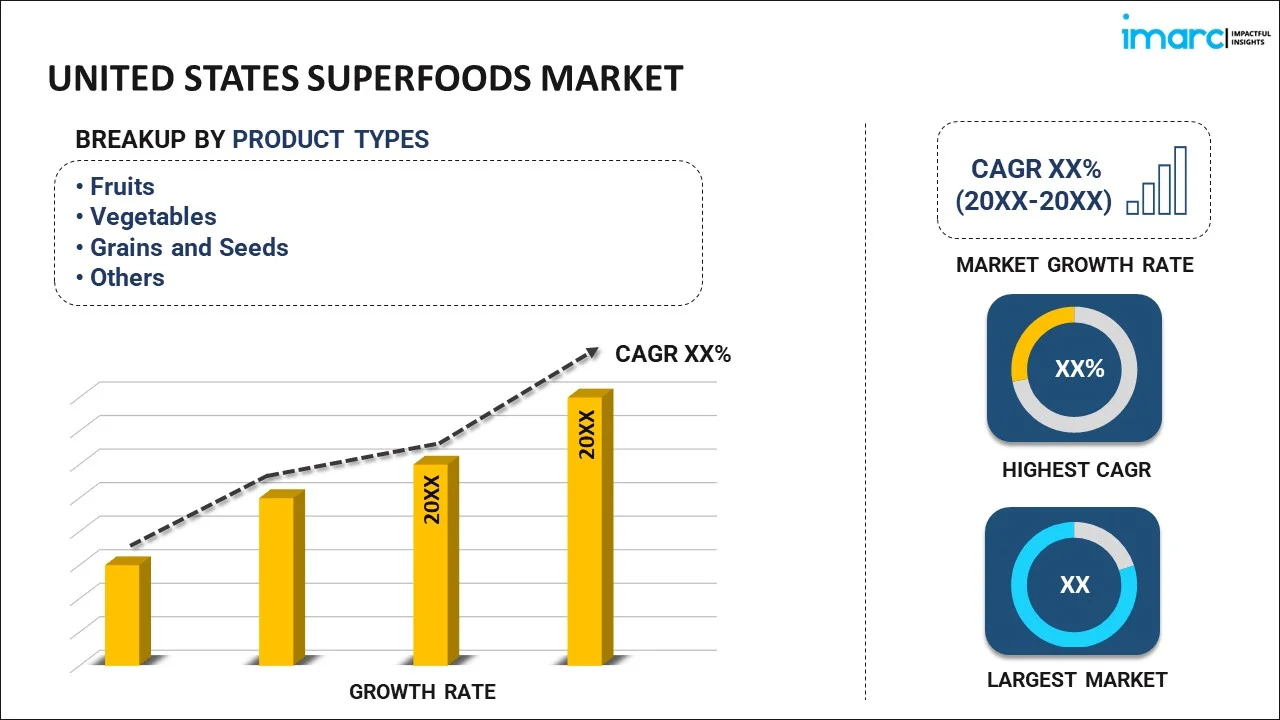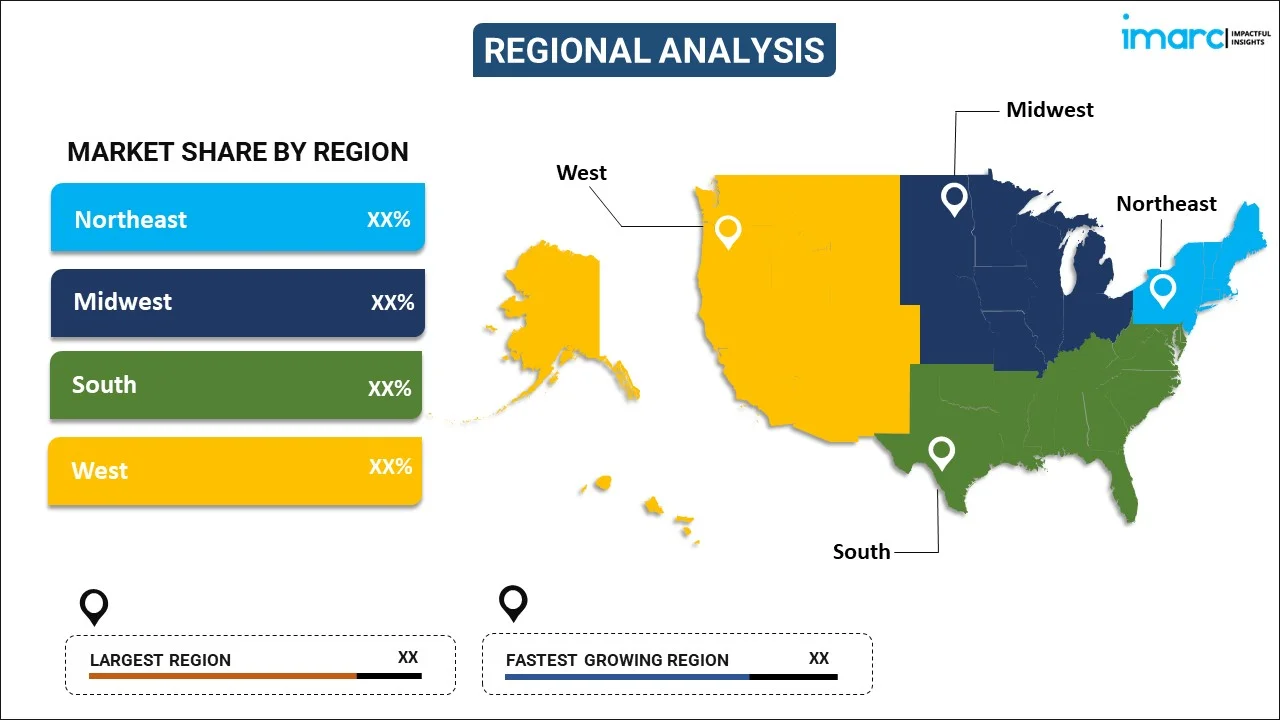
United States Superfoods Market Report by Product Type (Fruits, Vegetables, Grains and Seeds, Herbs and Roots, Meat, and Others), Application (Bakery and Confectionary, Beverages, Supplements, Convenience/Ready-to-eat foods, and Others), Distribution Channel (Supermarkets and Hypermarkets, Convenience Stores, Specialty Stores, Independent Small Grocery Stores, Online Sales, and Others), and Region 2025-2033
Market Overview:
The United States superfoods market size reached USD 44.4 Billion in 2024. Looking forward, IMARC Group expects the market to reach USD 66.6 Billion by 2033, exhibiting a growth rate (CAGR) of 4.6% during 2025-2033. The growing health consciousness, escalating demand for functional foods, increasing awareness about balanced diets, rising influence of media and marketing, and introduction of a variety of superfood-based products represent some of the key factors driving the market.
|
Report Attribute
|
Key Statistics
|
|---|---|
|
Base Year
|
2024
|
|
Forecast Years
|
2025-2033
|
|
Historical Years
|
2019-2024
|
|
Market Size in 2024
|
USD 44.4 Billion |
|
Market Forecast in 2033
|
USD 66.6 Billion |
| Market Growth Rate 2025-2033 | 4.6% |
Superfoods are nutrient-dense foods that are considered to have exceptional health benefits. These foods are often rich in vitamins, minerals, antioxidants, and other beneficial compounds. While there is no official scientific definition for superfoods, the term has gained popularity in recent years due to the increasing interest in nutrition and wellness. Superfoods are typically plant-based, although some types of fish and dairy products may also be included. Some commonly recognized superfoods include berries (such as blueberries, acai berries, and goji berries), leafy greens (like kale, spinach, and Swiss chard), nuts and seeds (such as almonds, chia seeds, and flaxseeds), fatty fish (like salmon and sardines), and certain grains and legumes (such as quinoa and lentils). These foods are celebrated for their high nutrient content and potential health benefits. For instance, berries are known for their antioxidant properties, which help protect the body against damage from harmful molecules called free radicals. Leafy greens are packed with vitamins, minerals, and fiber, promoting overall health and reducing the risk of chronic diseases. Nuts and seeds are excellent sources of healthy fats, protein, and essential nutrients, while fatty fish provide omega-3 fatty acids, which are beneficial for heart and brain health.
United States Superfoods Market Trends:
There has been a significant shift towards healthier lifestyles and a greater emphasis on preventive health measures in the United States. Consumers are becoming more aware of the connection between diet and well-being, leading to a growing demand for foods that offer exceptional nutritional benefits. Superfoods, with their high nutrient content and potential health benefits, align well with this health-conscious mindset. Additionally, superfoods are often categorized as functional foods, which are products that provide additional health benefits beyond basic nutrition. Functional foods are gaining popularity as consumers seek ways to address specific health concerns or optimize their well-being. Superfoods like berries, leafy greens, and nuts offer a wide range of functional properties, such as antioxidant, anti-inflammatory, and immune-boosting effects. Other than this, the United States has seen a surge in awareness of the importance of a balanced diet in maintaining good health. Superfoods are often promoted as key components of a well-rounded and nutrient-rich diet. They are viewed as a means to fill nutritional gaps and meet recommended dietary requirements, contributing to the overall health and wellness of individuals. Besides this, the media plays a crucial role in shaping consumer preferences and driving market trends. The promotion of superfoods through various media channels, including social media platforms, television, magazines, and health blogs, has created significant awareness and interest among consumers. Effective marketing strategies by food companies and retailers have helped popularize superfoods and increase their availability in the market. Moreover, the superfoods market in the United States has witnessed continuous product innovation to cater to evolving consumer preferences and demands. Food manufacturers have introduced a variety of superfood-based products, such as powders, bars, snacks, beverages, and supplements, offering convenience and versatility to consumers. These innovative products have expanded the accessibility and consumption of superfoods beyond their natural form.
United States Superfoods Market Segmentation:
IMARC Group provides an analysis of the key trends in each segment of the United States superfoods market report, along with forecasts at the country level for 2025-2033. Our report has categorized the market based on product type, application, and distribution channel.
Product Type Insights:

- Fruits
- Vegetables
- Grains and Seeds
- Herbs and Roots
- Meat
- Others
The report has provided a detailed breakup and analysis of the market based on the product type. This includes fruits, vegetables, grains and seeds, herbs and roots, meat, and others.
Application Insights:
- Bakery and Confectionary
- Beverages
- Supplements
- Convenience/Ready-to-eat foods
- Others
A detailed breakup and analysis of the market based on the application has also been provided in the report. This includes bakery and confectionary, beverages, supplements, convenience/ready-to-eat foods, and others.
Distribution Channel Insights:
- Supermarkets and Hypermarkets
- Convenience Stores
- Specialty Stores
- Independent Small Grocery Stores
- Online Sales
- Others
The report has provided a detailed breakup and analysis of the market based on the distribution channel. This includes supermarkets/ hypermarkets, convenience stores, specialty stores, independent small grocery stores, online sales, and others.
Regional Insights:

- Northeast
- Midwest
- South
- West
The report has also provided a comprehensive analysis of all the major regional markets, which include Northeast, Midwest, South, and West.
Competitive Landscape:
The report has also provided a comprehensive analysis of the competitive landscape in the United States superfoods market. Competitive analysis such as market structure, key player positioning, top winning strategies, competitive dashboard, and company evaluation quadrant has been covered in the report. Also, detailed profiles of all major companies have been provided.
United States Superfoods Report Coverage:
| Report Features | Details |
|---|---|
| Base Year of the Analysis | 2024 |
| Historical Period | 2019-2024 |
| Forecast Period | 2025-2033 |
| Units | Billion USD |
| Scope of the Report | Exploration of Historical and Forecast Trends, Industry Catalysts and Challenges, Segment-Wise Historical and Predictive Market Assessment:
|
| Product Types Covered | Fruits, Vegetables, Grains and Seeds, Herbs and Roots, Meat, Others |
| Applications Covered | Bakery and Confectionary, Beverages, Supplements, Convenience/Ready-to-eat-Foods, and Others |
| Distribution Channels Covered | Supermarkets/Hypermarkets, Convenience Stores, Specialty Stores, Independent Small Grocery stores, Online Sales, and Others |
| Regions Covered | Northeast, Midwest, South, West |
| Customization Scope | 10% Free Customization |
| Post-Sale Analyst Support | 10-12 Weeks |
| Delivery Format | PDF and Excel through Email (We can also provide the editable version of the report in PPT/Word format on special request) |
Key Questions Answered in This Report:
- How has the United States superfoods market performed so far and how will it perform in the coming years?
- What has been the impact of COVID-19 on the United States superfoods market?
- What is the breakup of the United States superfoods market on the basis of product type?
- What is the breakup of the United States superfoods market on the basis of application?
- What is the breakup of the United States superfoods market on the basis of the distribution channel?
- What are the various stages in the value chain of the United States superfoods market?
- What are the key driving factors and challenges in the United States superfoods market?
- What is the structure of the United States superfoods market and who are the key players?
- What is the degree of competition in the United States superfoods market?
Key Benefits for Stakeholders:
- IMARC’s report offers a comprehensive quantitative analysis of various market segments, historical and current market trends, market forecasts, and dynamics of the United States superfoods market from 2019-2033.
- The research study provides the latest information on the market drivers, challenges, and opportunities in the United States superfoods market.
- Porter's five forces analysis assist stakeholders in assessing the impact of new entrants, competitive rivalry, supplier power, buyer power, and the threat of substitution. It helps stakeholders to analyze the level of competition within the United States superfoods industry and its attractiveness.
- Competitive landscape allows stakeholders to understand their competitive environment and provides an insight into the current positions of key players in the market.
Need more help?
- Speak to our experienced analysts for insights on the current market scenarios.
- Include additional segments and countries to customize the report as per your requirement.
- Gain an unparalleled competitive advantage in your domain by understanding how to utilize the report and positively impacting your operations and revenue.
- For further assistance, please connect with our analysts.
 Inquire Before Buying
Inquire Before Buying
 Speak to an Analyst
Speak to an Analyst
 Request Brochure
Request Brochure
 Request Customization
Request Customization




.webp)




.webp)












